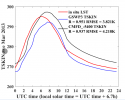oleson, thank you for your help . There are four questions. (1) Is there any configuration of greenwich (e.g., true or false) in CLM model? (2) The in-situ LST was calculated based on atmospheric downward longwave radiation, surface upward longwave radiation and ground emissivity, If I want to compare model output 0.5hrly LST with in-situ LST, which output variable (e.g. TG and TSKIN) should I adopt ? (3) According to your opinion, I doubt the LST peak difference (1-1.5hr) between model output TSKIN and in-situ LST may be due to time zone and greenwich time configuration. My study area is located at 100.4°E (local time=UTC+6.7), the model forcing data is UTC time, in-situ data is recorded with Beijing time (i.e., site time =UTC +8), so I compared the first value output from the model(00:00 UTC)with the 8:00 recorded by the site, then I found the model outpu TSKIN was 1-1.5 hours later than in-situ LST. Do you have any suggsetion? This problem has troubled me for a long time (see the screenshot1 and 2 below) (4) For 0.5 hourly model output, I found the model output TBOT and FSDS( bilinear interpolation)were always 0.5 hour later than the input TBOT and FSDS, thus resulting 0.5/1 hour later of TG/TSKIN than in-situ LST. In addition, when the interpolation method of solar was changed to coszen, the output TG/TSKIN was found 1/1.5 hour later than in-situ LST. In principle, the model output should not change input FSDS and TBOT. Do you know why? (see the screenshot3(FSDS) and screenshot4 (TBOT) below).If you believe that the forcing data is setup correctly, then I wouldn't recommend moving it around just to get model output variables to match up with whatever in-situ data you might have. There could be many reasons why model output, e.g., TG doesn't agree with in-situ data (e.g., surface characterization, deficiencies in parameterizations). I assume you are accounting for any difference in time zone between the in-situ and model data.
note: my forcing data Precip: first time stamp is 0 and the offset = -5400. Solar: first time stamp is 0 and the offset = -5400. TPQW: first time stamp is 0 and the offset = 0. CLDAS LST is an LST(TG) product with 1hr resolution.






